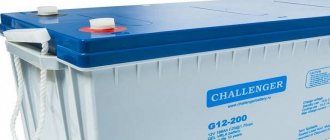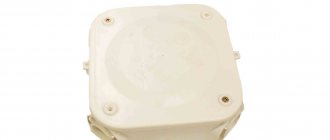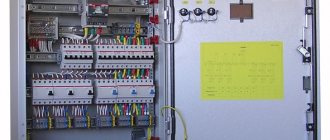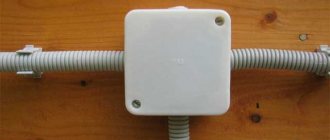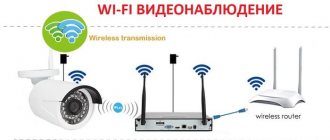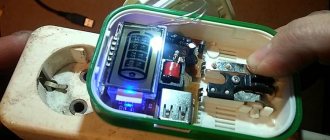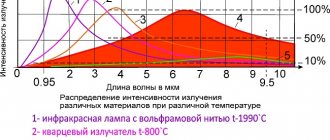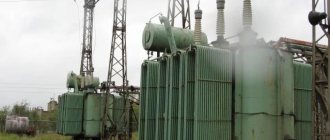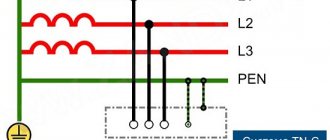I'm lying about what it is in electrical engineering. What is VRU? How does lying stand for?
Home » Electrical installation » Electrical panels » Types of electrical panels
People who often come across different electrical panels have noticed that they have a wide range. To understand which electrical panel is best to choose, you need to know what the letter codes that are indicated on its box mean. In this article we tried to consider the types of electrical panels.
Mounting panel
We tried to consider only popular equipment, as well as the goals and objectives that each individual type of electrical panel performs.
ASU equipment
Input and distribution devices can be equipped in different ways, depending on the wishes of the customer and existing requirements. Basically, ASUs in electrical facilities are equipped with protective automation, an electrical energy meter, measuring equipment and buses.
If we talk in more detail about the components of the ASU, they are as follows:
- Electricity meter.
- Input circuit breaker and incoming RCD.
- Group circuit breakers and RCDs (or automatic circuit breakers).
- Busbars (grounding, neutral, conductive).
- Wires and cables necessary for connecting all equipment.
- Stacked terminal blocks for switching circuits.
In addition, depending on the field of application of input distribution devices, they can be equipped with current transformers, quartz fuses, voltage limiters, voltmeters, ammeters, arresters, protective equipment and other devices. As already mentioned, the configuration of the ASU depends on the power supply project and the individual preferences of the customer.
Annual maintenance of ASU and main switchboard
2 times per year
The following routine maintenance work is carried out on input distribution devices (IDUs) and main distribution boards (MSB):
- checking the main grounding bus (GZSh) (according to the standards of PTEEP Appendix 3, clause 28.11): checking the tightening of bolts and the integrity of welded contact connections;
- there should be no cracks or mechanical damage on the surface of the clamp;
- there should be no corrosion on the steel connecting clamps;
- in the welded joint there should be no cracks, burns, craters, or lack of penetration of the weld more than 10% of its length at a depth of more than 15% of the thickness of the metal being welded.
Input distribution device (IDU). Types and application
The name input-distribution device (IDU) indicates that it is mounted at the input of electrical networks of several consumers, distributes electricity across them, and allows automatic power outage in the event of malfunctions and short circuits. With the help of an ASU, it is convenient to disconnect the electrical circuit in the house during repair work, or for a period of prolonged inactivity of the electrical circuit.
In multi-storey residential buildings, such an input system is installed in vestibules or stairwells. In small two-story houses, such an electricity input device is placed on the outside of the house. In factories, such devices are mounted in the workshop or on the outer wall of the production building. Typically, the input distribution device is used for alternating current voltage of 220 or 380 V.
Types of ASU
Electricity distribution and input devices are classified according to various criteria: the number of protective and other devices, size, current strength. Some samples have a special place for energy meters, and there are also devices that control the operation of lighting. Electrical circuit breakers located in the ASU housing serve for automatic emergency de-energization of circuits.
According to the purpose and characteristics of the ASU device, they are divided into the following types:
- Input systems responsible for receiving electricity.
- Distribution type, designed for distribution and accounting of data.
- Input and distribution systems that simultaneously perform the functions of the two previous types.
By current load on:
- 250 amp.
- 400 amp.
- 630 amp.
Design features
These devices differ significantly in size, since much depends on the power of the connected consumers. In turn, this indicator is related to the number of consumers who need electricity.
The input distribution device belongs to the group of electrical devices, which include various devices. The ASU not only receives energy, but also distributes it among objects. Each large residential building must have a separate ASU installed.
If the main facility consists of additional individual consumers, then additional ASUs are installed at each facility.
ASU equipment and devices are placed in metal cabinets, which consist of the following parts:
- The wires are connected to the copper busbars using a bolted connection. To increase the reliability of contact of power circuits, spring washers are additionally used. The phase bus must have holes for connecting consumer phase conductors. Working neutral conductors going to the consumer are connected to the neutral bus, which has similar holes.
- The input machine is used to connect the power cable. The parameters of the machine are determined in accordance with the power supply project.
- Fuses can be installed instead of an input circuit breaker and are intended for the same purposes. Their rating is also selected in accordance with the load size.
- The input circuit breaker protects the electrical wiring of the household network from excessive loads, short circuits, and also for performing power outages for network maintenance.
- Voltage limiters or arresters. They are installed after the input machine. If pulse overvoltages occur, the arrester is triggered. In this case, phase voltage is supplied to the protective bus, as a result of which the protection of the switchgear is triggered.
- A group of machines for individual networks. The main task of these machines is to distribute electricity among separate groups. Each group serves a separate room in the apartment, lighting and other various consumers requiring separate protection. If necessary, install protective shutdown devices. The machines are connected taking into account a uniform load for all phases. The number of machines in each phase is determined by the highest load of the connected networks.
- Wires and terminal blocks for making various connections. The wires must have the insulation color according to their intended purpose: phase - red wire, neutral wire - blue, ground - yellow-green. The ends of the wires must be marked. The phase bars must be painted in different colors. Conductors must have insulation suitable for 660 volts. At the point where the wires are introduced into the input distribution device, they are enclosed in bushings to ensure reliable insulation.
- Electricity consumption metering devices. Metering devices installed in these devices make it possible to control electricity consumption and the optimal distribution of loads in different circuits.
Electrician's notes: what is an ASU
Their task is to enter, distribute and account for consumed electricity.
Thus, devices of the VRU-1 series are mainly used in public utilities and protect all equipment in the building and electrical distribution circuits extending from the device from overloads and possible fire due to a short circuit. There are several types of input distribution devices, but all of them are equipped with a steel housing with a protective coating. The cases are produced in a standard size with removable side panels and a certain degree of protection regulated in GOST R 51732-2001. Protection is often used on the bottom of the device, which allows it to be placed on the floor.
What you need to know
Before purchasing an input distribution device, it is necessary to draw up a plan for its placement at the site, work out the electrical circuit, fill out questionnaires from the manufacturer - if necessary, deviate from the standard circuit. The price of the device will be determined in accordance with your requirements.
The ASU cabinet must be installed in an accessible place where it will be possible to service it, as well as electric lighting and natural ventilation equipped. Regulatory requirements also require placement at a distance of at least one meter from all communication networks.
In accordance with the Rules for the Construction of Electrical Installations, the air temperature in the room should not be lower than +5 degrees, the doors in the room with the installed ASU-8504 should open outward. If electrical equipment is installed in basements where there is a risk of groundwater ingress, the cabinets must be secured to the wall above the flood level. Only an electrician with appropriate education and experience should have access to the premises and equipment to avoid any accidents.
quantumelektro.ru
Operating principle of the ASU
The main power cable is inserted directly into the device's input circuit breaker. The rated current is calculated in advance and reflected in the project or technical specifications. The input circuit breaker protects electrical wiring during emergency situations. With its help, it is possible to deliberately turn off power for network maintenance work. In some ASU designs, the input circuit breaker can be replaced with a switch or a special disconnector.
The arresters are installed behind the introductory machine. Here the connection of phase wires and the PE protective bus takes place. When pulse overloads occur, the arresters are triggered, phase voltage enters the PE bus and the final activation of the ASU protection occurs.
The final distribution of power supply, in accordance with groups of wires, is carried out using circuit breakers with different ratings. Each group of consumers is connected to a separate circuit breaker. As additional protective measures, if necessary, RCDs are installed.
The installation of distribution machines must ensure uniform load distribution between all phases. When calculating machines for each phase, the demand coefficient must be taken into account, which determines the probability of maximum load on electrical networks.
Daily maintenance of ASU and main switchboard
1 per day
The following maintenance work is carried out on input distribution devices (IDUs) and main distribution boards (MSB):
- control of basic network parameters using built-in voltage and current measuring instruments;
- assessing the performance of meters based on changes in readings when the load is running;
- determination of the position of protection and switching devices (off, on);
- indoor temperature control internally and remotely;
- monitoring of security and fire alarm sensors based on the working indication of the sensor;
- visual inspection of electrical panel lighting fixtures, and, if necessary, troubleshooting.
The photographs below illustrate the process of maintaining the input distribution device in one of the cottages in the Moscow region.
Requirements for measuring instruments and operating conditions of premises with ASU and main switchboard
Stationary measuring instruments used to control the operating mode of electrical equipment and power lines must be marked with a mark corresponding to the nominal value of the quantity being measured.
The rooms in which input distribution devices and main distribution boards are installed must have natural ventilation and electric lighting. The temperature in the room with the ASU and main switchboard should not be lower than +5°C.
Installation and connection of the input distribution device
Installation of input distribution devices is carried out according to an electrical diagram, according to which all actions are performed in a certain sequence. Violation of the procedure is completely unacceptable due to electrical safety requirements.
When replacing an ASU, at the very beginning of work, the facility is disconnected from the power source and completely de-energized. After this, the input power cables are disconnected, the electrical equipment and ASU to be replaced are dismantled. Next, the installation of new input distribution devices is carried out. There is an approved diagram for the correct selection of fasteners. Then the cable is laid and all the wires are sealed. The supply wires are supplied and fixed to the new electrical equipment, the input cables are connected to the central switch or to other types of disconnecting devices. The assembled electrical circuit is tested, and all its elements are marked. After this, the object is connected to the supply feeder.
Differences between VU (input device) and ASU (input distribution device)
In the IU (input device), unlike the ASU, there are no circuit breakers for distributing power supply to individual groups. The input device is installed either on a power line pole (as in the photo), or near the house or in the house itself. The ASU is installed only in the house.
Water devices can be with or without electricity meters. But here it is necessary to note:
Note: According to the latest regulations, the electric meter must be installed outdoors. In a sealed case with a transparent window for reading meter readings. Therefore, organizing the power supply at home according to the scheme: power line, VU (input device), electric meter, on the street, and only then a separate distribution board in the house, is quite justified.
Composition of the Verkhovna Rada
Kharechko Yu.V. in his book [2] he described in great detail what functional blocks and panels an ASU can consist of. Here are the relevant quotes from his book:
“Input distribution devices consist of functional blocks, which are understood as a set of interconnected equipment installed in the ASU, which ensures the performance of certain functions. In a multi-panel ASU, the functional block can be made in the form of a panel that provides a specific function. »
Input distribution devices can have the following functional blocks [2]:
- input block through which electricity is supplied to the ASU. This functional block contains switching and protective equipment, and also includes part of the ASU volume necessary for placing, fastening and connecting the supply network (circuit) conductors to the equipment;
- an automatic backup power supply unit (ABP), containing monitoring and control equipment for the switching equipment of the input unit, to which backup power supplies are connected;
- an electricity metering unit containing a direct or transformer-connected electricity meter, current transformers and a test adapter box;
- distribution block containing switching and protective equipment of distribution and final electrical circuits. This block also includes part of the ASU volume or panel for placing and connecting conductors;
- an automatic lighting control unit containing switching and protective equipment for the final electrical circuits of general house lighting and control equipment for these circuits.
Multi-panel input and distribution devices consist of panels, which are detachable parts of a multi-panel ASU, made on a single structural basis with other panels and containing corresponding functional blocks.
Input distribution devices may have the following panels [2]:
- an input panel containing switching and protective equipment, as well as control equipment for input and electricity metering units;
- input panel with ATS, which is an input panel equipped with an ATS unit;
- a distribution panel containing equipment for distribution units, which can also house electricity metering units, automatic or non-automatic lighting control units, etc.;
- fire-fighting device panel, which is a distribution panel that is attached to the input panel with automatic transfer switch and is designed to power electrical equipment and control circuits of fire extinguishing equipment, alarm circuits of fire-fighting devices, evacuation lighting and other electrical receivers necessary for warning and extinguishing a fire.
